Recent Fire Damage Posts
The Speed of a House Fire | SERVPRO® of West Hamilton/Oxford
5/19/2023 (Permalink)
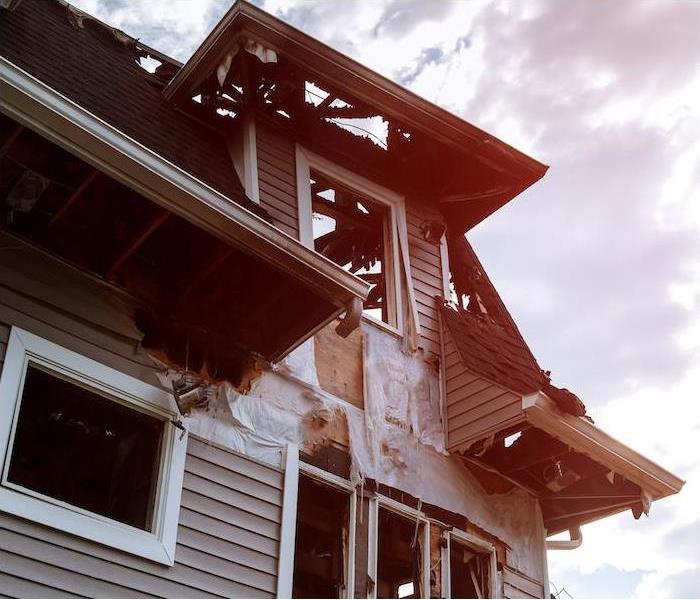 Fires spread fast. When disaster strikes, call SERVPRO of West Hamilton/Ohio to help so you can focus on what matters most.
Fires spread fast. When disaster strikes, call SERVPRO of West Hamilton/Ohio to help so you can focus on what matters most.
Experiencing a house fire is one of the more overwhelming and frankly terrifying things a homeowner can go through. Any time a fire breaks out in a place that it shouldn’t, it can spread quickly and cause widespread damage in a short amount of time. Some fires can’t even be contained, leading to a total loss of home or property.
If a fire starts in your home, getting out safely should always be your top priority. Understanding the progression of a house fire and how to get out quickly is crucial to ensure everyone in your family remains safe.
Fire Spreads Fast
All it takes is a single spark from an unattended candle or a kitchen towel too close to a stove burner for a fire to start. Once something flammable is ignited, it only takes about 30 seconds for the small flame to become a large fire.
From there, it is only a matter of minutes before that fire has created enough black smoke to fill a room or the entire house.
Once that smoke is in the air, it can become virtually impossible to see. That black smoke is thick and can throw an entire room into darkness. In under two minutes, the fire and smoke can become life-threatening and in under five minutes, your entire home could be engulfed in flames.
How You Should React
If a fire starts while you are home, your first priority should be to get out of the house as quickly as you can and call 911.
The fire will quickly start to produce black smoke, so stay low to the ground as you find your exit. The toxic smoke and gasses that fire produces can make you disoriented and drowsy, so crouch or crawl towards your exit if you have to.
Once you are outside, head to your pre-discussed meeting location and ensure that all of your family members have made it out safely. By this time, the fire department should be arriving soon and will take over to extinguish the flames and control the situation.
What to Do After
Standing in the aftermath of a house fire can be a really isolating and overwhelming experience. If the fire was widespread, you could be dealing with a full reconstruction as well as coming to terms with the loss of your possessions and keepsakes.
Our SERVPRO of West Hamilton/Oxford team understands the sensitive and stressful nature of experiencing a house fire, and we will help guide you through the restoration process one step at a time.
We will work together to create a restoration plan, and we will do our best to save as many of your possessions as possible. We are here 24/7 to respond to your call for fire damage restoration.
We can help you recover from any sort of fire disaster. Contact us at SERVPRO of West Hamilton/Oxford.
4 Tips for Maintaining Your Smoke Alarms
6/27/2022 (Permalink)
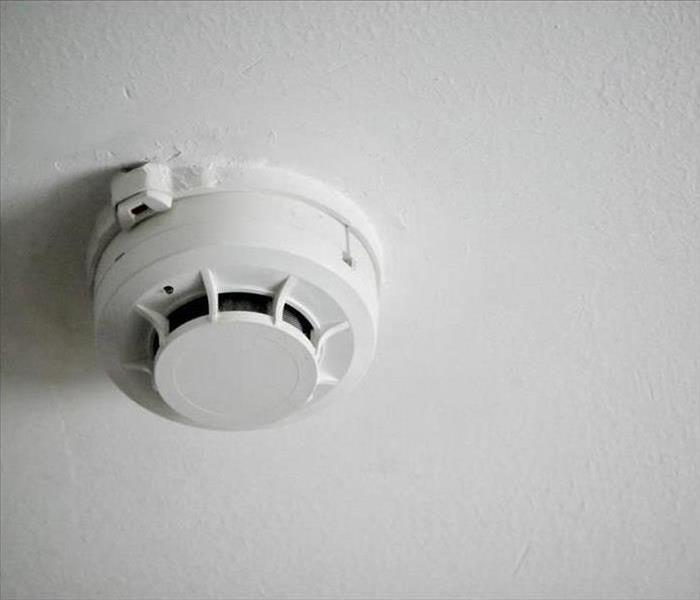 A properly working fire alarm is key for keeping you safe from flames.
A properly working fire alarm is key for keeping you safe from flames.
Fire Alarm Tips
Millions rely on smoke detectors to alert them of a fire in their home, but are you aware of how many you'll need or how to maintain them? Here are four important fire alarm tips for preventing a disaster in your Reilly, OH, home.
1. Determine How Many You Need
First and foremost, you should determine how many smoke alarms you currently have and if you require more. Ideally, each home should be equipped with an alarm inside each bedroom and outside every sleeping area. There should be at least one on every level of a house, including basements. Do a walkthrough of your home to pinpoint alarm locations and determine if you require more.
2. Understand Which Fire Alarm Sensor You Have
There are two types of alarm sensors: photoelectric and ionization alarms. The former is geared toward detecting smoke damage and slow-smoldering fires, while the latter better detects fast-moving flames. It's advised to have both types of sensors within your house as you cannot predict which type of fire danger will occur.
3. Rotate Batteries Regularly
For optimal performance, change the batteries in every detector in your house roughly every six months. This ensures your alarm will not fail you in an emergency. If you don't follow this timeline, most models will let you know when it's time for a replacement by sounding off high-pitched beeps.
4. Keep Records of Alarm Installation
Just like their batteries, fire detectors don't last forever. It's advised to replace your alarms about every ten years, so keep a record of when they were installed to determine when it's time to replace them. Insufficient alarms can leave a fire not only endangering your family but destroying your home to the point where only fire damage restoration professionals can repair it.
A properly working fire alarm is key for keeping you safe from flames. Make sure your home has enough sensors and keep up with routine maintenance for maximum safety.
Where To Safely Put Your Space Heater
5/25/2022 (Permalink)
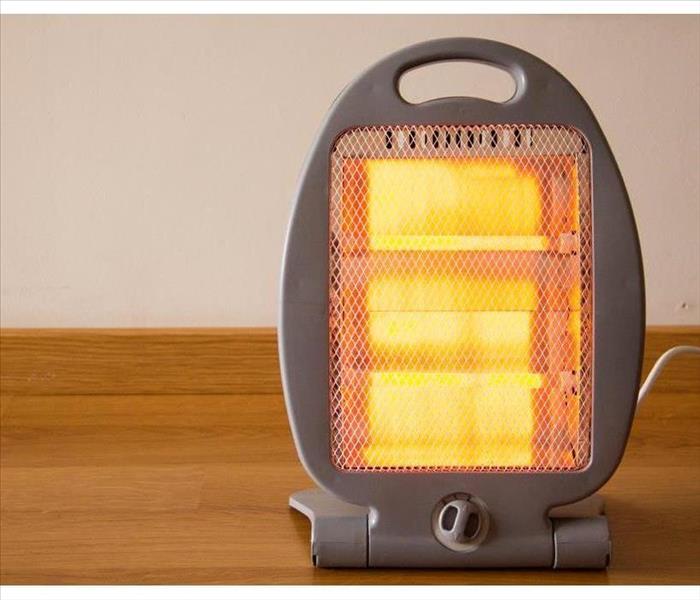 Place your space heater in a safe place.
Place your space heater in a safe place.
Place Your Space Heater Safely
If you are like many people, then you probably use a space heater to stay comfortable when the temperatures drop in Millville, OH. As convenient as these little heat blasters may be, though, a burned space heater can also be deadly. Every year, approximately, 25,000 residential fires start because of them.
While there are several ways you can reduce the risk of this kind of fire damage, one of the top things to consider is where you put the heater. To lower the chances of needing a smoke cleanup team the next time you try to warm up your house in the morning, try one of these locations instead of the bed or the carpet.
In the Bathroom
While bathrooms often do not have carpeting, you still need to consider flammable furnishings such as:
- Rugs
- Window curtains
- Shower curtains
- Towels
When you are using your heater in the bathroom, make sure it stays on the tile and away from any cloth or paper that may be nearby.
In the Bedroom
When it comes to the bedroom, there are probably more opportunities for a burned space heater to occur. If you have carpet, you should reconsider putting your heater in a bedroom at all. Not only does this device need to stay on the floor, but it should only be placed on a hard surface like wood, tile or laminate. Because it is unsafe to sleep while a space heater is on anyway, keeping it away from your resting place is probably a good idea.
In the Living Room
The living room is another location where you can find a lot of potential fire starters, yet it is also a common space for families to gather. If you want to heat up this area of your home, look for a suitable place to set the heater. If you have a fireplace area or another part of the room with solid flooring, that should be the spot.
There are many ways to avoid a burned space heater. Knowing where to put it is one of the simplest and most effective.
How To Choose a Fire Restoration Company for Your Business
3/28/2022 (Permalink)
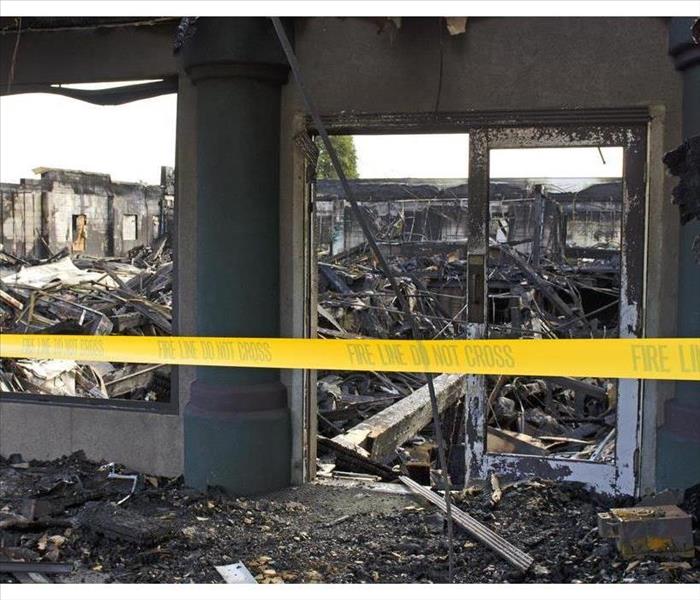 Commercial fire damage in Morgan Township, OH.
Commercial fire damage in Morgan Township, OH.
What to Look for When Choosing a Fire Restoration Company for Your Company
When fire ravages your business in Morgan Township, OH, the damage can seem daunting. A fire damage restoration company assesses the damage done and works to restore the business sooner than you think. Each company should use specific steps to restore the business after a commercial fire. Knowing what to expect can help you choose the right company for your business.
1. Availability
The fire restoration company should be available immediately. A commercial fire is an emergency and the restoration company should be ready to act. Your business needs immediate relief to prevent further damage.
2. Assessment
Once the fire is out, the restoration company assesses the damage left behind by fire, smoke and soot. Without assessing the extent of the damage, the restoration company cannot come up with a good plan for smoke cleanup. The estimated costs depend on how well the company can assess the damage.
3. Prevention
One of the benefits of hiring a professional fire damage restoration services company is preventing additional damage to your property. The company should work to address immediate concerns first. Burst water pipes and roof holes should be a top priority to start mitigating the damage.
4. Clean
Once the immediate concerns are handled, the company can start the clean-up efforts. Soot, dust and smoke cleanup is part of the process. Water from the sprinkler system or burst pipes will be removed. The building will slowly get looking back to normal.
5. Repair
The final step in the fire restoration process is repair. The business may need to replace furniture or flooring if it was too damaged by the commercial fire. Use this as an opportunity to rethink the décor of your building.
Choose a fire damage restoration company that follows these steps. Some companies offer a debriefing after the cleanup is finished. In addition to helping you come up with ways to prevent future fires, the company may recommend new smoke detectors or fire prevention methods.
Mitigation Companies vs. Restoration Companies What’s the Difference?
1/28/2022 (Permalink)
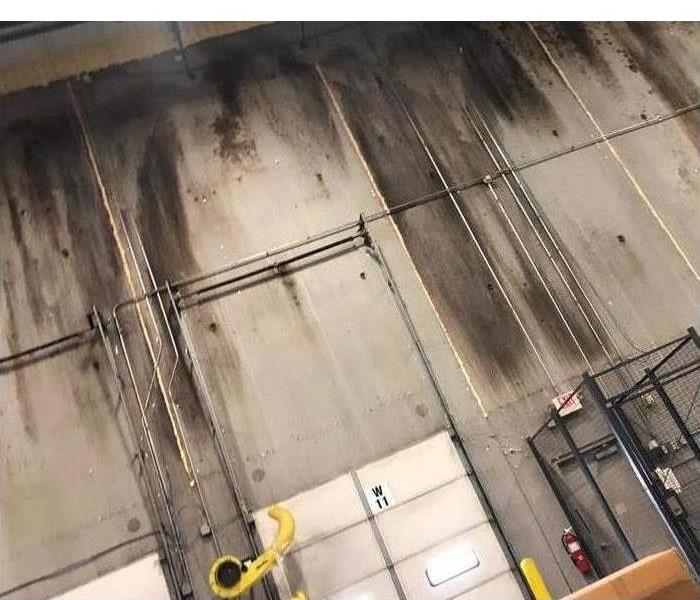 Fire damage in Layhigh, OH.
Fire damage in Layhigh, OH.
Mitigation or Restoration
Mitigation or restoration - these are common terms to come across when handling fire damage cleanup, and for the novice, it may not seem like there’s much of a difference. But the fact is, there are significant differences that can have major financial impacts: Some insurance plans cover mitigation services after a disaster and others only cover restoration services. Not knowing the difference can cost you big. Learn more about the difference between these two services and how they can help your Layhigh, OH, business in the wake of fire damage.
What’s Mitigation?
Many companies advertise themselves as fire mitigation specialists. Mitigation generally refers to reducing the severity of something, in this case, the impact of fire damage. Mitigation companies try to limit ongoing damage and stave off continued losses using tools and methods like:
- Boarding up windows
- Adding roof tarps
- Removing water from firefighting efforts
- Securing the structure against collapse
It’s important to understand that they do not repair or replace, but rather, ensure the disaster doesn’t continue to have consequences.
What’s Fire Restoration?
After mitigation, it’s time for restoration. Restoration experts aim to rebuild and repair your property. They may replace walls damaged by fire or floors and carpets damaged by standing water. They can combat mold, odors and infestations, while making your property livable again. The key difference between restoration and mitigation is how it enables you to move forward. Mitigation sets the stage for fire cleanup. Restoration allows your business to get back to normal.
Fire restoration efforts pair naturally with mitigation and it’s not a question of one being better than the other, rather, which one you need at the time. The fact is, you’ll probably need both, but you may need to figure out which one insurance covers and which one you’ll need to finance. Talk to your insurance adjuster to learn about your options.
When To Schedule Furnace Maintenance
12/10/2021 (Permalink)
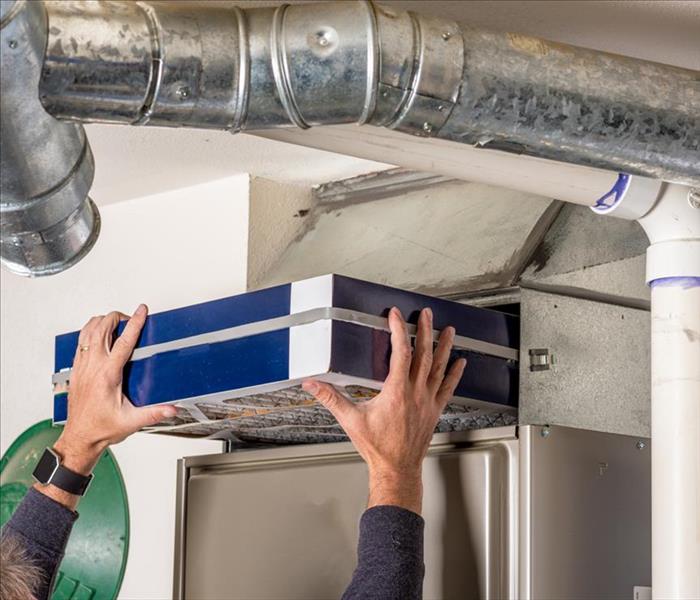 A furnace requires regularly scheduled maintenance to operate safely.
A furnace requires regularly scheduled maintenance to operate safely.
When Should Furnace Maintenance Be Scheduled?
Regular furnace maintenance can promote safety and keep heating costs low. Experts recommend scheduling a professional inspection at least once a year and performing regular checks and maintenance on a furnace in a home in Oxford, OH. Follow these guidelines to prevent a heating fire and the need for fire cleaning.
Once a Year
Schedule an appointment with a furnace service every year before the weather gets cold. An appliance specialist should test the factors that impact the operation of a furnace, such as the static air pressure, gas pressure, combustion gases and temperature rise. Furnace components that should be inspected on an annual basis include:
- Blower motor and wheel
- Condensate drain and trap
- Drainage system
- Electrical wiring or gas lines
- Heat exchanger
An inspection may cost anywhere from $80 up to $150. This preventative investment is less expensive than cleaning up after a fire. Make sure that the furnace service technician checks and cleans every component that is necessary to keep the furnace functioning safely.
Several Times a Year
A homeowner should also regularly check the condition of a furnace and clean any components that have accumulated dust or debris. Every few months, particularly during the winter, it is a good idea to take a look at:
- Burner flame and ignition
- Blower door seal
- Filters
- Air intake
- Ventilation system
Use a vacuum to remove buildup from furnace components. A clean furnace will function at maximum efficiency with less risk of fire.
A furnace requires regularly scheduled maintenance to operate safely. In addition to a professional inspection every fall, homeowners should also perform periodic checks when the furnace is being used daily or frequently. If a heating fire breaks out, it will be necessary to replace the furnace. A fire cleaning restoration and smoke cleaning service can also restore damage caused by a furnace fire at a residence in Oxford, OH.
Protecting Your Pets During a Fire Emergency
10/25/2021 (Permalink)
 Include your pet in your fire escape plan.
Include your pet in your fire escape plan.
Pet Safety Tips
Any fire emergency in an Oxford, OH, home can be devastating, but losing a pet during a fire can make the situation even more tragic. To prevent this from happening, there are several pet safety tips you should put in place to protect your furry friends from potential harm:
Include Pets in Your Evacuation Plans
• Put someone in charge of making sure your animals are with you during an evacuation.
• Make sure your pets will respond when they are called. Practice calling them when there are distractions so you are confident they will respond appropriately in a fire emergency.
• Have a firebox in your home that contains any important pet information (ownership documents, vaccination records, veterinarian information, etc.) that you can easily take with you during an evacuation.
• Put a pet first aid kit with your family’s first aid supplies so you can grab it without wasting additional time during an evacuation.
• Stick a “pet alert” window cling on a front window or door that indicates how many pets you have and where they are in the house. This helps firefighters locate your pets during a fire.
• Do not try to find a pet if they don’t respond. The most important thing to do is make sure you and your family get out of the house safely.
Have Pet Plans in Place for After a Fire
Most residential fires result in serious damage that may mean you have to stay someplace else until your house is cleaned, repaired and restored. This can take several days or longer; during this time, you may need to board your pets or temporarily house them with friends or family. As part of your pet preparation, consider boarding your pets or having them visit your friends before there is a fire so they can adjust more easily when there is an emergency.
Surviving a fire emergency can be traumatic for you and your pets. Restoring your home to a livable condition is crucial to getting your life back to normal. Restoration specialists in Oxford, OH, can make the transition smoother and get you and your pets back home sooner.
Tips To Prepare Kids for a House Fire
7/22/2021 (Permalink)
 By teaching and practicing safety fire tips with your children your family is prepared for a home fire.
By teaching and practicing safety fire tips with your children your family is prepared for a home fire.
Your kids’ safety is of utmost importance. You teach your children to look both ways before crossing the street and to stay away from strangers. But, as a parent and homeowner in Morgan Township, OH do you educate your children on what to do in a home fire? When a fire emergency occurs, every second counts. Have a fire escape plan and practice it with your children. Review the tips below to educate your family.
Practice a Fire Escape Plan
Teach and practice the following techniques with your children during a non-emergency, so your family knows what to do in the case of a home fire:
- If the smoke alarm sounds at night, roll to the edge of the bed face down, place the closest hand to the floor and slide off the bed.
- Crawl to avoid smoke in the air on knees and forearms with head down, or crawl like a snake.
- Check doors before opening by feeling for heat. If hot, find another way out of the room. If warm or cool, open slowly and check for fire. Close doors as you go.
- Create and practice an escape route and agree on an outdoor meeting place. If trapped, go to the window, open it, climb out if possible or yell for help. Once out of the house, do not return inside for any reason.
Preventative Measures for Kids
Aside from teaching and practicing the above techniques, follow these kids’ safety tips:
- Maintain at least one functioning smoke detector at each level of your home. Teach your children that the alarm sound means there is fire and smoke in the house.
- Keep lighters and matches out of the reach of young children. Instruct older children not to play with these or other flammable objects, such as candles.
By teaching and practicing the above tips with your children in Morgan Township,OH your family is prepared for a home fire. Once your kids’ safety is secured and the fire is out, contact a fire restoration specialist and your homeowner’s insurance agent to begin the process of returning your home to preloss condition.
Smart Smoke Detector: To Buy or Not to Buy
7/6/2021 (Permalink)
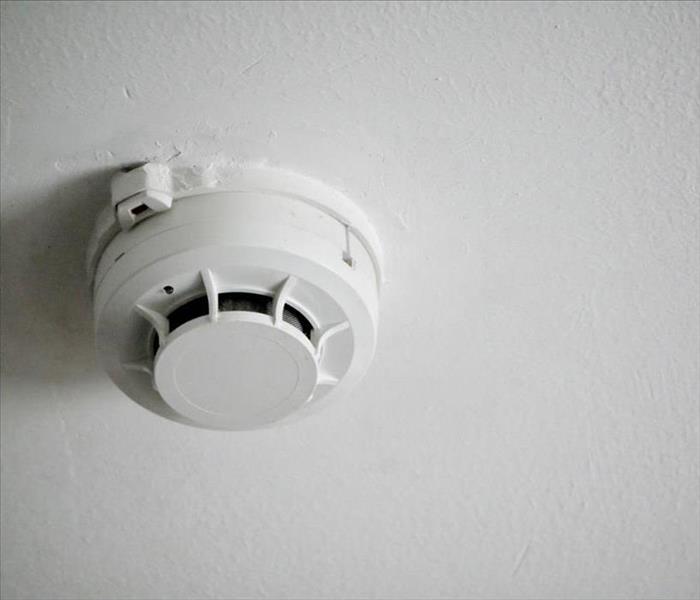 A smoke alarm can be one of the wisest decisions you ever make.
A smoke alarm can be one of the wisest decisions you ever make.
Should a Smoke Alarm Cost Over a Hundred Dollars?
Companies developing new smart detectors think they should, but are the improvements a luxury or a necessity? You be the judge.
1. Expense Versus Performance
When comparing performance against the expense, you can be blinded by the technological gadgetry of smart detectors. True, most smart detectors can connect and communicate with your other smart devices, but does this bonus contribute to its effectiveness? Most reviewers don’t think so, claiming that a regular smoke detector functions and performs the same as a smart detector, without the bells and whistles.
2. Convenience Versus Luxury
The argument to buy or not to buy comes down to convenience versus luxury. A regular smoke alarm is a bargain find, costing around $20, but a smart detector can cost upward of $100. The inter-connectedness and advanced notifications equate to the increased price tag.
3. Technology Versus Necessity
Fire safety may be a necessity but is it necessary to shut off a detector from your phone or to be notified of a fire when you’re not home? These tools may be beneficial, but that does not mean they are necessary. Regular detectors have worked well for decades with simple batteries and buttons.
4. Preparation Versus Spontaneity
No matter your decision, you may want to invest in fire preparations because spontaneity puts both you and your property at risk. Many fire departments recommend having an evacuation plan in case of a fire and practicing that plan with your family monthly. Additionally, you may want to work with a company in Hanover Township, OH, that specializes in emergency planning as preparation for a crisis, like a fire.
A smoke alarm can be one of the wisest decisions you ever make, but do you need a smart alarm? All smoke detectors work the same way and, by many accounts, perform equally. The most significant differences between smart alarms and regular alarms are in the advanced notifications and ease of use, but does that make them worth the price tag? What do you think?
3 Common Causes of a Lint Fire in Your Dryer
3/22/2021 (Permalink)
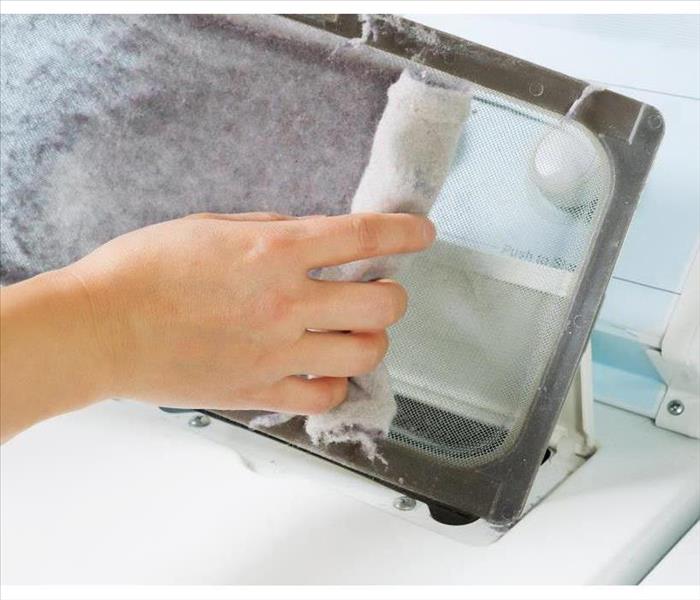 Clean your lint filter before and after each use of your dryer.
Clean your lint filter before and after each use of your dryer.
Three Common Causes Of Lint Fire In Your Dryer
Homeowners in Reilly, OH, whose dryers are no longer functioning, should think twice before purchasing a new appliance. Lint buildup is a common cause of a malfunctioning dryer. It is also a lint fire hazard that may go unnoticed for years. Lint can accumulate in places where it is hard to spot, such as:
- Dryer vents
- Inside the dryer
- Behind the dryer
Lint is made up of small thread particles, such as wool or cotton, that easily combust. These three common causes of a dryer fire should be prevented.
1. Failure to Maintain the Dryer Vent
Experts recommend that you service your dryer at least once a year to prevent a lint fire. Fluff and fuzz can fill the exhaust hose and dryer vent. An appliance that no longer dries your clothes is a sign that the vent is clogged. When the lint has no exit, it will eventually fill the vent until it has no other escape except into your home.
2. Lint Inside the Dryer
You should clean your lint filter before and after each use of your dryer. Lint is visible on the filter but can hide inside of the dryer as well. When you remove the filter, peer inside of the housing to make sure no fluff is left behind. If you see buildup inside of the filter housing, clean it thoroughly with a vacuum cleaner to prevent a dryer fire.
3. Lint Behind the Dryer
Lint hidden behind the dryer is a sign that the vent needs to be cleaned. Any spark near the lint can cause a house fire. To prevent this, clean behind your dryer regularly to keep lint buildup at a minimum. Then, contact a professional to service your dryer annually.
Contact your local fire damage restoration service if there has been a fire in your home due to lint. Taking preventative measures, such as yearly dryer maintenance, will keep your house safe from a lint fire.
3 Safe Alternatives To Traditional Candles
1/28/2021 (Permalink)
 Candles can be pleasant to look at, but they also present a risk of fire to your Hamilton, OH, home.
Candles can be pleasant to look at, but they also present a risk of fire to your Hamilton, OH, home.
3 Safe Alternatives To Traditional Candles
Traditional candles can make your Hamilton, OH, home look beautiful and add a touch of elegance to any room. However, they also come with a high risk of fire danger. If you love candles but worry about them causing a fire, there are several candle alternatives you can use to retain their scent and stylish appearance while keeping your home and family safe.
1. Wax Melts
Wax melts come in a huge variety of scents and colors so you can collect them to melt for almost any mood or season. They are also inexpensive, which means you can splurge on your favorites. These cubes melt in an electric ceramic warmer that uses a light bulb for its heat source. The warmer and the flameless heat source lowers the risk of fire considerably.
2. Electric Candles
If a fire damage and restoration company has deemed your home at risk for candle fires, you might want to consider buying electric candles instead of traditional ones. These battery-powered candles mimic the light and pleasing flicker of flame, but they stay cool to the touch. This makes them one of the safest candle alternatives available today.
3. Oil Warmers
If you enjoy the scent of candles but not the risk of a candle fire, then you might want to invest in a few oil warmers for your home. These warmers run on electricity and can be plugged in almost anywhere. There are dozens of different scented oils available, and many of them can now be found in large retail and grocery stores. Although the heat source of the warmer makes the oil give off a pleasant fragrance, the risk of fire is low because there is no open flame.
Candles can be pleasant to look at, but they also present a risk of fire to your Hamilton, OH, home. Using candle alternatives can lower this risk considerably while making your house look and smell beautiful.
Getting To Know Fire Extinguishers
12/14/2020 (Permalink)
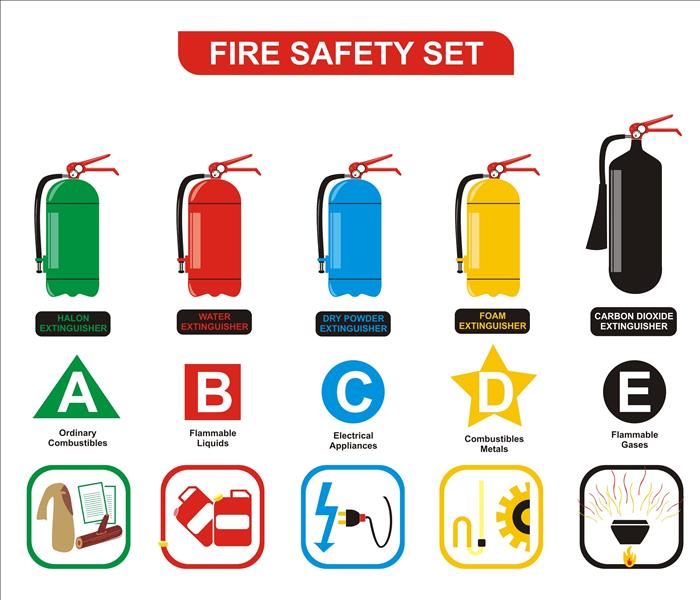 There are three types of household extinguishers
There are three types of household extinguishers
A fire extinguisher is a must-have for your home in Hamilton, OH. It can keep a small fire from getting out of hand or give you time to escape a large one. Choosing the right extinguisher is important, as is understanding how to use one.
Types of Extinguishers
There are three types of household extinguishers:
- Type A: Fires from combustibles like wood, cloth and paper
- Type B: Fires caused by flammable liquids like cooking oil or gasoline
- Type C: Electrical fires
Many household models are classified for all three fire types.
Extinguishers are available in disposable and rechargeable varieties. While rechargeable models are more costly, it is usually cheaper to refill them than purchase another disposable one when the gauge indicates low pressure.
The label shows the extinguisher's classification rating. The higher the number, the greater the effectiveness against each type of home fire.
Extinguisher Weights
The weight of an extinguisher refers to the amount of chemical inside. A 2-pound fire extinguisher is best for the car, a 5-pound model is good for the kitchen or laundry room and a 10-pound extinguisher is appropriate for a work area or garage.
How To Use an Extinguisher
For fire preparedness, it's best to know how to use an extinguisher before an emergency arises. An easy way to remember the steps is to use the acronym PASS:
- P: Pull the extinguisher's pin.
- A: Aim at the base of the fire, not at the flames above.
- S: Squeeze the trigger to release the agent.
- S: Sweep the extinguisher back and forth until the flames are gone.
After a Fire
Don't hesitate to call emergency services if you doubt whether the fire is out. Even a small fire can cause smoke, water and chemical damage in your Hamilton, OH, home. An emergency restoration company can help you clean up and restore your house to its pre-fire condition.
Along with an escape plan, owning a fire extinguisher and knowing how to use it is the best way to be prepared for a fire emergency in your home.
How To Prepare a Fire Escape Plan for Your Business
10/26/2020 (Permalink)
 Workplace security mandates that every company has a contingency plan at the ready
Workplace security mandates that every company has a contingency plan at the ready
Prepare a Fire Escape Plan For Your Business
When it comes to minimizing harm during a fire, having a contingency plan in place is the most important measure any business can take. Follow the below guidelines to create one for yours.
Check Your Equipment
Before establishing an evacuation plan, make sure you have up-to-date and operable:
- Emergency lights
- Fire doors
- Extinguishers
- Alarms
- Bullhorns, whistles or megaphones
These items are critical to executing effective, organized escapes during emergencies in Morgan Township, OH. If your location needs improvements in relation to any of these elements, consult a fire safety expert who can provide proper guidance.
Create Your Plan
Discuss with your team where fires are likely to break out, why they might start and what should be done during specific scenarios. Your contingency plan will benefit greatly if you first examine the overall picture before getting lost in the details.
Have at least two escape routes for every location. Post maps illustrating these paths in clearly visible, well-trafficked areas. Reinforce this information through mass emails explicitly outlining specific steps to be followed. Remind employees that heavy equipment such as chairs and filing cabinets can be used to break windows if an alternative passage is needed.
Designate outside spots where groups are to gather. The individual tasked with performing a headcount should have everyone’s name and assigned assembly point at the ready. Remember that each post must be spacious enough to comfortably accommodate the expected number of employees.
Running practice drills provides assurance that everyone knows exactly where to go and what to do during a true fire event. Besides extensive damage requiring a commercial fire restoration professional to fix, actual blazes create panic and confusion. Therefore, never warn your staffers ahead of time. The element of surprise is an essential ingredient in revealing any plan’s weaknesses.
Workplace security mandates that every company has a contingency plan at the ready. Put one together as soon as possible if yours is not already protected.
The Fire Damage Restoration Process
9/15/2020 (Permalink)
 Board up home in Millville, OH after fire damage
Board up home in Millville, OH after fire damage
The Following Steps Outline The Process
Fire and smoke damage to your Millville, OH, home can be a major hassle. Fortunately, understanding the restoration process can help you get your home back to normal more quickly.
1. Assess Damage
After the authorities say it is safe to do so, return to the property and survey the damage. Take photographic or video documentation for the insurance company.
2. Secure Property
Board up or tarp over broken windows and other openings in the structure to keep out wildlife and inclement weather. In some cases, it may be necessary to install a security fence to keep trespassers from entering the property.
3. Dry Property
If water was used to extinguish the fire, dry out the property as soon as possible. Wet/dry vacuums, pumps and dehumidifiers can all help with this process. If the outdoor humidity is low enough, you can also open windows and doors to increase airflow. Remember to act quickly because mold can begin to grow in as few as 24 hours.
4. Clean Affected Areas
Soot and smoke damage can be particularly difficult to deal with. Smoke odor can linger for years if not properly addressed, and soot damage can be compounded if the wrong cleaning products or methods are used. Fortunately, an experienced restoration service can make sure soot and smoke cleaning are both done thoroughly and correctly.
5. Repair and Replace Damaged Items
Depending on the extent of the fire damage, you may be able to salvage some items. Some homeowners can complete simple repairs themselves, but many will need professional assistance, particularly with delicate items like antiques and electronics.
A damaged building is vulnerable to wildlife and vandals. Standing water fosters mold growth, and soot can be corrosive. If your home experiences fire and smoke damage, it is important to begin the restoration process as quickly as possible to prevent further damage.
Can Office Electronics Still Work After a Fire?
7/1/2020 (Permalink)
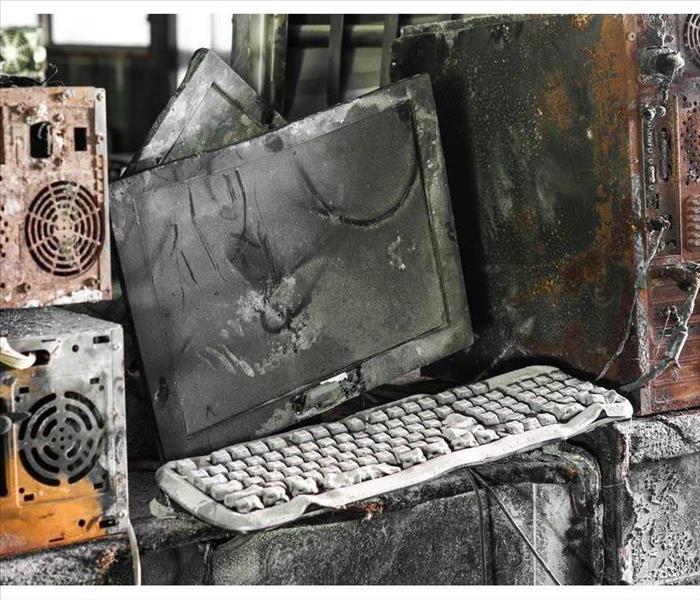 Do not use electrical equipment that has been exposed by heat.
Do not use electrical equipment that has been exposed by heat.
Electronics are very sensitive to heat and smoke. After a fire at a commercial building in Morgan Township, OH, these devices are some of the most costly contents to clean or replace. The condition and electrical fire risk of an appliance, computer, or device depend on the proximity to open flame, the highest temperature reached, and whether the device was powered on during a fire and extinguishing process.
Check the Condition
An external visual inspection may be enough to determine whether electronics have been exposed to open flame, intense heat, smoke, and soot. The following factors often determine the viability of a fire-damaged device:
- Melted exterior or components
- Signs of being burnt or charred
- Indications of water exposure
Damage may be more significant if a device was powered on during a fire. A building or business owner should never attempt to turn on electronics that may have sustained fire damage. These items can cause an electrical fire.
Get an Expert Opinion
Content cleaning specialists have access to clean rooms and precision equipment for assessing the condition of electronics. Since smoke damage can corrode metal, it is important to look beyond surface issues. In a safe environment, trained experts can check the condition of circuits and internal components.
Restore or Replace Electronics
It may be more affordable to replace some electronics than to attempt computer cleanup or repair. Circuits or other components exposed to high heat or water may not be capable of reliable repair to reduce the risk of another fire. In many cases, it is safer to replace electronics affected by the fire and retrieve and transfer any data that can be salvaged from the physical memory of devices.
A building or business owner should never attempt to test electronics by turning an appliance, computer, or device on after a fire. Specialized equipment is necessary to safely determine whether electronics are likely to short-circuit and start an electrical fire.
Proper Fire Extinguisher Use
6/8/2020 (Permalink)
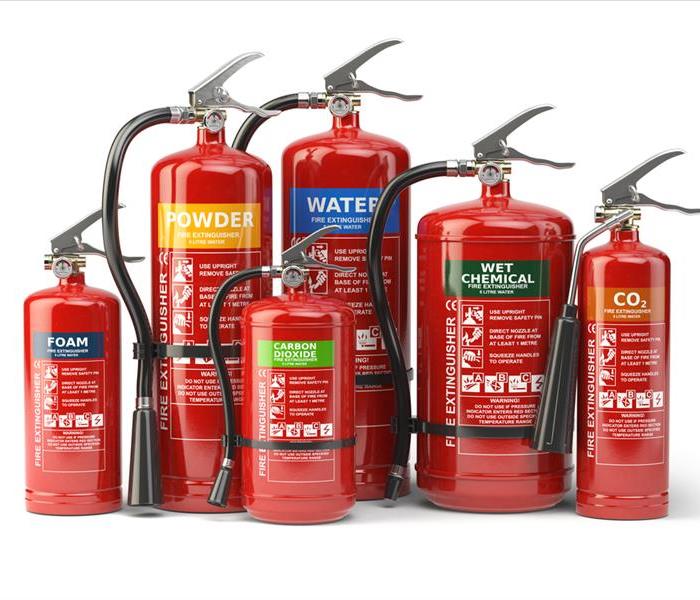 There are four main types of extinguishers
There are four main types of extinguishers
A fire in your Lemon Township, OH, home can easily lead to feeling panicked. If the flames are beyond putting out, get out and call 911. Safety should be the top concern. A smoke and fire damage restoration expert can repair the losses. If you have confidence that is a manageable small fire, the best defense is to grab the fire extinguisher. Before that situation ever happens, it is important to understand the type of extinguishers that are in your home and how to properly use them.
Types of Extinguishers
There are four main types of extinguishers typically found in a home that are used for specific causes of a fire.
Class A: Solid combustibles, such as wood, paper, and fabric
Class B: Flammable liquids, such as oil, petroleum, and gasoline
Class C: Electrical, such as faulty wiring, fuse boxes, and appliances
Class K: Cooking oils and grease, including animal and vegetable fats
Every extinguisher is clearly labeled to ensure it is used in the right situation. There are also some combination extinguishers designed for use on A, B, and C fires. For a kitchen fire caused by grease, a Class B or K should be used.
Proper Use
If the time comes to use a fire extinguisher, below are three important steps to take.
Before using it, determine the safest escape route, as well as a backup route, in case you are unable to put out the fire.
Keep space between you and the fire. A good rule of thumb is a minimum of six feet away.
Face the fire and prepare to follow the PASS method of use. Pull the pin. Aim the nozzle at the base of the fire. Squeeze lever or handle to discharge. Sweep nozzle side to side until the fire is out.
A fire extinguisher is the first line of defense for keeping a small flame from turning into a big fire. Beforehand, knowing the types you have and how they work can help you stay a little calmer in a real emergency.
What To Know About Your Smoke Alarm
2/24/2020 (Permalink)
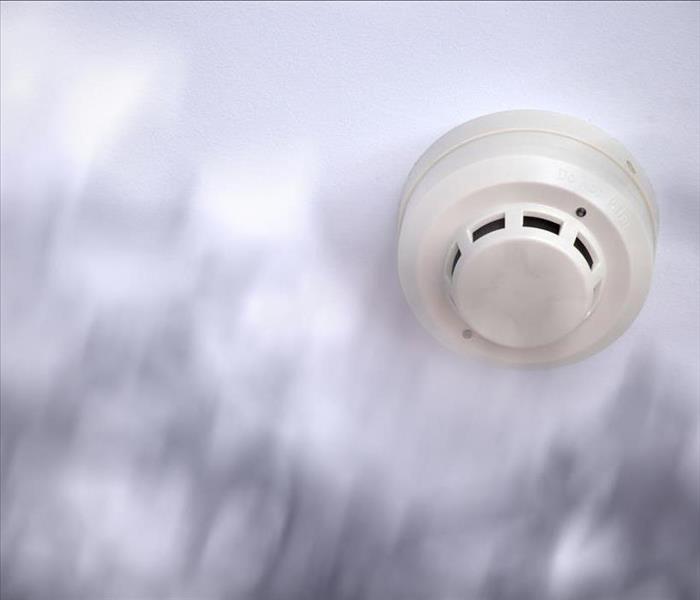 Regularly maintain your smoke alarm
Regularly maintain your smoke alarm
Three Things To Know About Installing Fire Alarms In Your Home
For a home in Hamilton, OH, having a smoke alarm installed is highly recommended by many fire damage restoration professionals to help protect your home. However, these units will need to be properly placed and maintained. Here are three things you should know about installing fire alarms in your home.
1. Alarm Maintenance
It’s important to properly maintain any alarms you may have in your home. Keep them clean and free of dust or cobwebs, and change the batteries at least once a year. It’s also important to test the unit according to the manufacturer's instructions. In many cases, this involves pressing the test button and listening for the appropriate alarm sound.
2. Alarm Lifespan
Another thing that should be noted about a smoke alarm is its operational lifespan. For most alarms, this lifespan is somewhere between eight and ten years. Units older than their recommended usage life should be replaced. If you need to know how long your alarm unit should remain functioning it’s best to consult the manufacturer's instructions.
3. Alarm Placement
When considering the placement of a smoke detector in your home many experts recommend having at least one on each floor. It’s also important to include an alarm in each bedroom as this can help protect your family should a fire occur while someone is asleep. Additionally, an alarm outside the bedrooms in a space such as a halfway can provide an additional measure of protection.
When installing a smoke alarm in your home it’s important to remember that the unit will need to be regularly maintained. It’s also a good idea to test the unit. Replace units over ten years old, and check the batteries in existing units at least once a year. You will also want to ensure that there is a minimum of one alarm per floor as well as one in each bedroom.
Fire Protection: What Renters Can Expect From Their Coverage
2/4/2020 (Permalink)
 Ask your insurance agent if you are covered
Ask your insurance agent if you are covered
Fire Protection: What Renters Can Expect From Their Coverage
What Renters Can Expect From Their Coverage
Many tenants buy renter’s insurance to cover the cost of replacing their personal belongings if they are damaged or destroyed by an accident in the building where they live. Your coverage, however, may pay for much more than just item replacement. It’s important to talk to your agent, so you know just how much you can expect your insurance company to pay if the place you are renting in Oxford, OH , catches fire.
Belongings
Part of the fire restoration process is determining which items can be cleaned and saved and which must be thrown away. Your insurance coverage should pay for:
- Assessment
- Cleaning costs
- Replacement costs
Make sure your policy states that it pays replacement cost rather than the actual cash value of your items. The purpose of insurance is to make you whole again, and replacing lost belongings is a good start.
Liability
If the fire was caused by your negligence, you might be liable for any damages you cause to other people or to the structure itself. Your renter’s insurance probably has a clause that protects you from legal costs. Your policy may cover damage to your neighbor’s belongings or the property itself, as well as cover medical bills of anyone injured in the fire if you bear some responsibility for its starting.
Shelter
Fire restoration experts may work quickly, but there are probably going to be some nights that you are unable to stay in your rented space. Finding a temporary place to live can be expensive. Your insurance policy is likely to cover this as well. You can include your shelter needs as part of the fallout of the fire damage to your home when you file your claim.
Your renter’s insurance does cover the loss of your belongings, but it can also cover other losses. Your insurance agent can help you build a solid policy that takes all potential expenses of the fire into consideration.
4 Guidelines for Safe Fire Alarm Usage
12/23/2019 (Permalink)
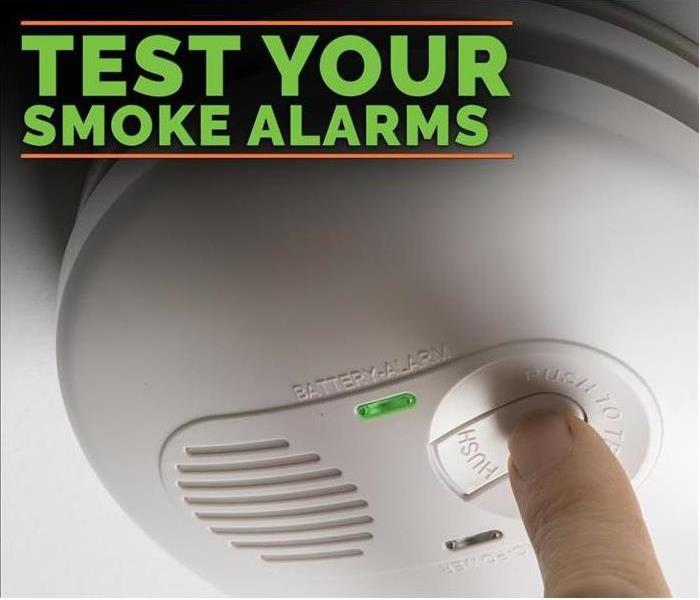 Test your smoke alarm monthly
Test your smoke alarm monthly
4 Guidelines for Safe Fire Alarm Usage
Fire safety is something children learn from a young age. Don't play with fire, stop drop and roll, and other common slogans may ring a bell. But for many homeowners, home fire safety comes with some glaring question marks. Do you know how to protect your Ross, OH, residence using best fire alarm practices? Whether you own a home or rent an apartment, proper installation, maintenance and use of your fire alert system can make a life-saving difference. The following four guidelines should be followed to keep your home and family safe from fire danger.
1. Install the Correct Number of Alarms
Whether you live in a studio apartment or a large estate, the National Fire Protection Association provides guidelines for installing smoke detectors in any sized dwelling. No matter the square footage, it is recommended that homes should have smoke alarms in each of the following places:
- Inside each bedroom
- Directly outside of sleeping areas
- Minimum of one on each level, including upstairs and downstairs
If your home is lacking the proper amount of detectors, look for easy-to-install models that can be adhered directly to the ceiling.
2. Replace the Batteries Regularly
Aside from avoiding those ear-piercing chips that come in the middle of the night, regular battery replacement is essential for safe operation of your fire alarm system. Battery replacement should be done one to two times each year to ensure your system is prepared for an incident involving smoke damage.
3. Replace Home Fire Alarms According to Manufacturer Directions
On average, your home fire detector has a life span of 8-10 years. Residents living in older structures should not overlook the fact that their alarms may be past the manufacturer guidelines for safety. If it's time to replace your alarms, don't fear. Most models can be found in the $10-$20 range making them very affordable.
4. Test Alarm Monthly
Finally, monthly testing of your fire alarm will help ensure that you have done your part to prepare for a possible house fire. Don't be caught unaware when your home and family are left with the aftermath of fire damage in Ross, OH.
What You Should Know About Smoke Detectors
11/23/2019 (Permalink)
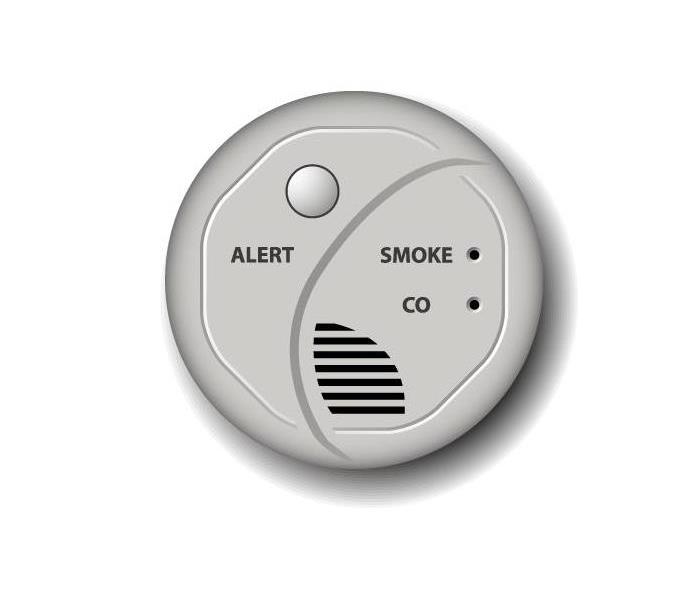 If you have a dual alarm, then you have an alarm that uses both types of detection
If you have a dual alarm, then you have an alarm that uses both types of detection
Things To Keep In Mind About Smoke Alarms
If you have ever had the unfortunate experience of having a house fire in Hamilton, OH, then you likely already know how devastating it can be. It can cause a great deal of damage, and it can even cause a home to be a total loss. While a fire damage repair specialist can help with the fire damage, it is not something no one wants to experience. In case of another house fire, your safety should be your biggest concern. One of the best things you can do to ensure the safety of you and your family is to have a working smoke alarm. Here are some things to keep in mind about smoke alarms.
Where to Place Them
Unless you live in a very small home, you will likely need more than one smoke alarm. It is recommended that you put one:
- In every bedroom
- On every level
- In each living area
This means that most homes will require several alarms.
Different Types
There are different types of smoke alarms. A smoke detector that uses ionization will be better at detecting a fire that spreads quickly, and a photosensitive detector will likely be better at a smoldering fire, or one that can be difficult to detect at first. If you have a dual alarm, then you have an alarm that uses both types of detection.
How Often to Test It
You want to test your smoke detector once a month, if not more frequently. Replace the batteries immediately if the alarm fails the test. Be sure to replace the batteries regularly. Some newer smoke alarms have batteries that can last up to ten years, but older alarms may require annual battery replacement.
These things can help you keep your family safe by ensuring you have a working smoke alarm everywhere you need to. Remember to test them regularly to ensure they are working properly, and replace any alarms or batteries that are no longer working.
Methods for Preserving Personal Belongings After a Fire
10/22/2019 (Permalink)
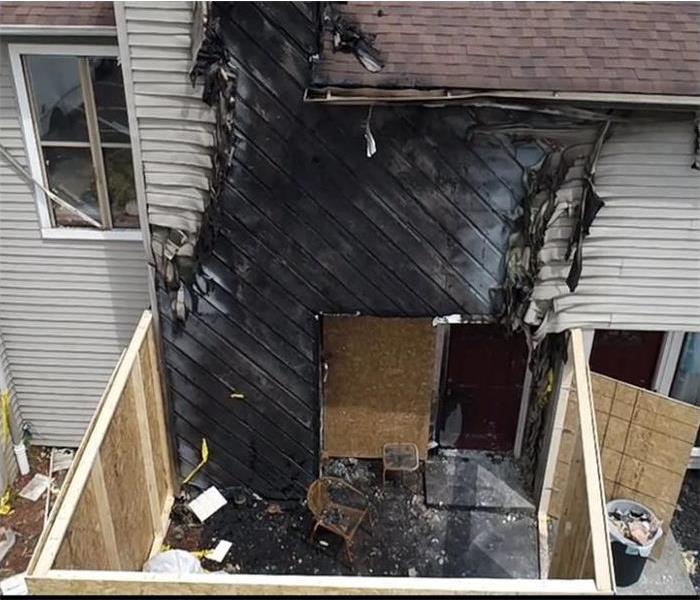 Fire Damaged an Apartment Building in Oxford, OH.
Fire Damaged an Apartment Building in Oxford, OH.
In-home fires can be devastating, and not only can they cause heat damage to a home’s structural integrity, but the smoke and soot that results from a fire can easily affect personal belongings in the home’s interior as well. While unfortunately not everything can be saved from the aftermath of a fire, these methods are available for content cleaning after a fire has occurred:
- Dry-cleaning can be attempted before wet-cleaning to eliminate light residue. While there are many ways to clean damaged items, this is the preferred method for smoke or soot-damaged clothing.
- Foam cleaning should be considered for fabrics that are not colorfast or those that may shrink if wet-cleaned.
- Immersion Cleaning requires dipping contents into a cleaning agent.
- Wet-cleaning can then be used for heavier or moderate residue removal.
An in-home fire is something no one wants to contend with. However, items can be saved afterward if proper content cleaning methods are employed.
3 Things to Remember About Fire Alarms
10/10/2019 (Permalink)
 Make sure to test your alarm at least once a month
Make sure to test your alarm at least once a month
3 Things to Remember About Fire Alarms
A smoke alarm is an essential part of every building, but you likely don’t give yours a lot of thought. These little devices can help you stay safe and can alert you in time to prevent severe fire damage from occurring in your home. The following are a few pieces of information about them that can be helpful for homeowners in Layhigh, OH.
1. There Are Several Types of Alarms You Can Purchase
When it comes to which fire alarm to put in your home, you have a variety of options. One feature that can vary between models is how the alarm is powered. Traditionally, smoke alarms have used 9-volt alkaline batteries that need to be replaced at least once a year. However, newer alarms sometimes use a lithium battery that lasts for the life of the device. There are even some types that connect to your home’s electric system. You can also choose between photoelectric and ionization alarms which detect different types of fires.
2. The Number of Alarms You Need Depends on the Size of Your Home
Not every house needs the same number of alarms. Generally, you need at least one fire alarm on each floor. You should also have one inside each bedroom and outside of each sleeping area so that you will wake up more quickly if an emergency occurs.
3. Alarms Should Be Tested Regularly
Because your fire alarm is an extremely important device, you should make sure that it is working properly at all times. Make sure to test your alarm at least once a month. You should also change the batteries once or twice a year if your smoke detector uses replaceable batteries. The device itself will need to be replaced at least every ten years.
While your alarm can help give you time to prevent a fire from getting bigger or allow you to get out of the house safely, it cannot keep all damage from happening. If you have fire or smoke damage in your home, a cleanup and restoration service can remove it and perform any necessary repairs to the building.
Having a Plan Can Save Your Life
7/15/2019 (Permalink)
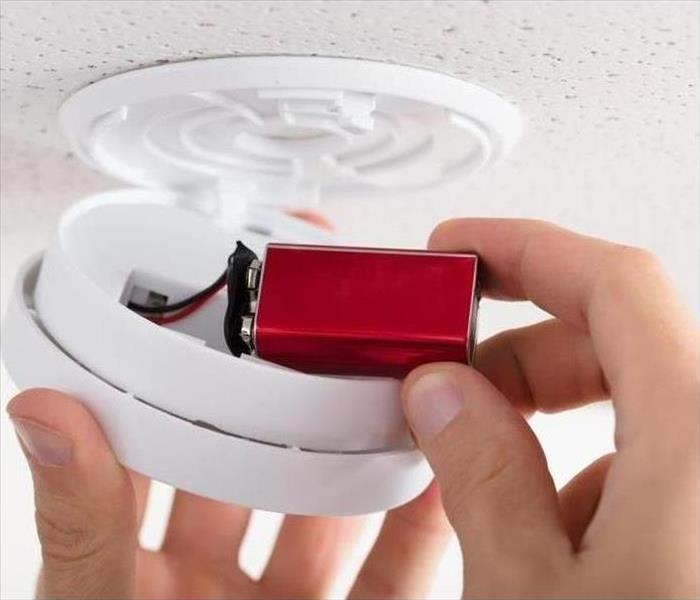 Being prepared can make all the difference in the world in the event of a fire.
Being prepared can make all the difference in the world in the event of a fire.
You might think that the fresh batteries in your smoke detectors are enough to keep you and your family safe in the event of a fire. While working smoke detectors and batteries certainly are a must, without a fire escape plan, how will you and your loved ones know what to do when the smoke detectors go off? If disaster strikes, you need a plan you can set in motion immediately. There’s an old saying that schoolteachers like to use: If you fail to plan, you plan to fail. In the event of an emergency, you don’t want to have to think on your feet; instead, you want to be able to take action – and fast.
According to the American Red Cross, the best way to protect yourself and your family is to create your very own emergency escape plan, and to practice it regularly. Here are the key elements of this kind of plan:
- If your home includes bedrooms above ground level, think about purchasing escape ladders for these rooms. Ladders can be kept close to the window.
- Make sure everyone in your home knows more than one escape route from each room in the house.
- Teach your littlest family members to dial 9-1-1 in case of smoke or fire.
- Choose a meetup spot outside, and let everyone know where it’s located.
- Fire drills are not just for schools – practice your own fire escape plan until you complete the drill in two minutes or less.
- Rehearse your plan using realistic conditions, like practicing in the middle of the night and using a low crawl to help minimize possible smoke.
Comfort in Planning
Being prepared can make all the difference in the world in the event of a fire. However, having a plan won’t stop a fire from starting. If fire does strike your Hamilton, OH, home, you can rely on fire restoration professionals to help you clean up. In the meantime, you can feel confident that the creation and practice of your family’s fire escape plan will reduce the risk of harm to you and your family if you’re the victims of a house fire.
Steps Kids Can Take to Safely Escape a House Fire
12/30/2018 (Permalink)
 Closing all doors in your home at night can help slow down the spreading of potential fire within your home
Closing all doors in your home at night can help slow down the spreading of potential fire within your home
It’s impossible to put into words the helpless, awful feelings you would feel if your home were to catch on fire. This is an event everyone dreads and hopes they never have to experience. If this terrible situation arises, however, kids’ safety is most critical. This is why it’s vital to teach your children how to quickly and safely get out of your Oxford, OH, home if you detect a fire.
First Steps
At the moment you know there is a fire in your home, you should think of your well-being and of your kids’ safety. Before you do anything, make sure everyone in your house knows about these vital steps:
- Have a predetermined meeting place.
- Call 911.
- Don’t go back into the home for belongings.
Crawl to Safety
One of the most effective escape methods to teach to children if a home fire occurs is the crawl. Smoke will rise, so it’s important to stay low. This will make it easier to breathe and to see where exits are. Teach children to get on all fours with their heads down to the floor. Alternatively, children can put their bellies on the floor and use their forearms and legs to move on the floor like a snake. This method is effective if the heat is especially intense.
Check Doors
Often, a house fire will start when children are sleeping in their rooms or when family members are in another room in the house with the door closed. A proper fire escape in these situations is most likely if children will learn to first press the backs of their hands up against the door. If the door is hot, kids shouldn’t open the door. If the door is not hot, make sure your kids know to slowly open the door a little and examine the area. If it’s safe to proceed, they may crawl out.
To ensure your kids’ safety, make sure they understand these guidelines. You can then have peace of mind everyone is safe and sound by the time firefighter and fire cleanup experts arrive.
Restoring Items Constructed From Non-Porous Materials
9/24/2018 (Permalink)
Not all methods can be used for cleaning all materials. Dry-cleaning should not be used for some items. For example, non-porous materials should be cleaned by using an ultrasonic cleaner. An ultrasonic cleaner uses ultrasound and a cleaning agent to clean damaged items. Cleaning with ultrasound can be useful for preserving an abundance of objects such as jewelry, electronic equipment, and vinyl records.
Cleaning Electronic Items
In the event that personal belongings are moved to content storage during post-fire home renovation, it is wise to keep in mind that time is of the essence when cleaning electronics. After smoke or soot has invaded electrical items, acid that is contained in the smoke residue can begin to corrode metal surfaces. While dry-cleaning clothing may be more of a priority after an in-home fire, electronic items will be hazardous to operate prior to a thorough internal and external cleaning. Local Hamilton, OH, professionals may be able to assist in the smoke and soot removal from electronic devices.
If proper content cleaning methods are employed items can be saved after a home fire.
Securing a Building After a Fire
8/28/2018 (Permalink)
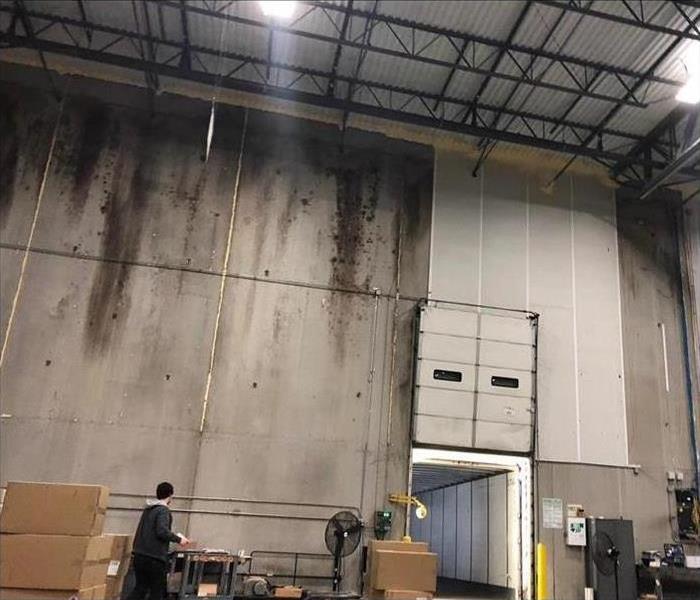 Fire damage on a factory in Ross, OH
Fire damage on a factory in Ross, OH
If you suffer the misfortune of fire damage at your Ross, OH, building, there are collateral concerns that are often an aspect of the disastrous experience. As incomprehensible as it may seem to good-hearted, law-abiding people, there are others who will resort to looting without a thought of the insult they add to your injury. That is why it is important to secure your building in the days, weeks and perhaps months it takes to make your building whole again.
Why and How to Secure Your Damaged Building
In addition to the threat of looters who could carry away valuable property, vandals might seize the opportunity to enact their own brand of criminal mischief. Mother Nature might be tempted to get in on the act as well, sending rain, snow, hail or winds to exacerbate the fire damage. Protect what is salvageable by boarding up:
- any openings in the roof
- missing doors and windows
- holes in walls, floors and ceilings
- bulkheads or other means of access
An unsecured building damaged by fire can become an attractive nuisance, and anyone who enters without your permission could become injured. Moreover, folks with legitimate reasons to be in or near the building such as insurance adjusters and assessment and restoration consultants hired to organize fire cleanup, fire inspectors and others will need to be protected as they work the site. Whether the building is in an urban, suburban or rural area, it is vital to keep out the curious, the criminal and the careless.
Accomplishing the remediation of fire damage to your building may well be more of a marathon than a sprint. A methodical approach is best and begins when everyone is safe, the fire is out, and the firefighters have left the scene. Secure your building with the help of professionals, tap into your well of patience and think positively as the restoration begins.
 Fires spread fast. When disaster strikes, call SERVPRO of West Hamilton/Ohio to help so you can focus on what matters most.
Fires spread fast. When disaster strikes, call SERVPRO of West Hamilton/Ohio to help so you can focus on what matters most.




 24/7 Emergency Service
24/7 Emergency Service























